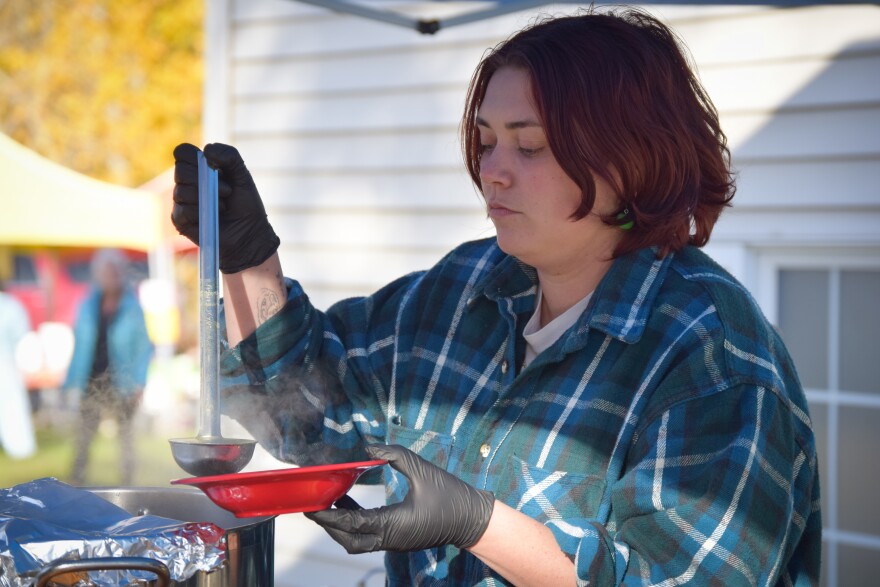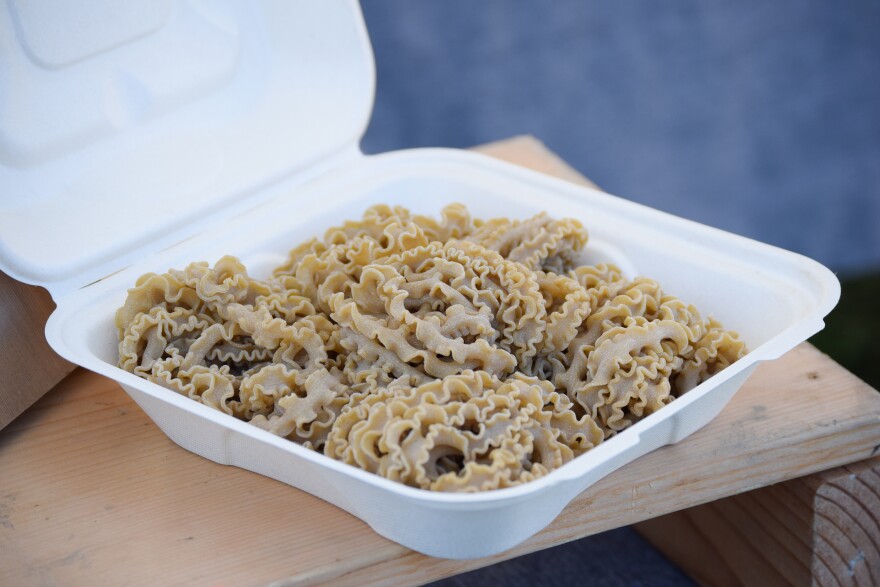This is the fourth story in a four-part series from the Alaska Desk called Shelf Life, which looks at food security in Alaska.
Tom Zimmer brought a hammer down on a slender length of metal while a class of teens looked on.
“They say, in the old days, you found the blacksmith shop not from the hammering but the cussing and filing of the apprentice,” he said between strikes. “We’ll try to keep that to a minimum.”
Blacksmithing isn’t Zimmer’s main job. He runs the Fairbanks nonprofit Calypso Farm and Ecology Center with his wife, Susan Willsrud. Most of their income comes from what they grow, like carrots, Brussels sprouts and peonies. But they supplement that with things like blacksmithing classes and wool dying workshops. They even have a yurt for rent.

“The vegetables and the flowers of the farm — that is the hub of the farm,” Zimmer said. “And then, the education and these other activities are spokes of the wheel.”
It’s not easy for small-time farmers to sustain themselves in one of the most extreme climates in the world. At more established farms, like Calypso, side projects are just supplementary income. But for many smaller, newer farms in Interior Alaska, they’re a financial lifeline.
Most of Alaska’s food is shipped in from somewhere else. But state lawmakers want to change that. Some are signaling support for Alaska’s growing farming industry to shore up the food supply.

Gov. Mike Dunleavy’s office is pushing to make the Department of Natural Resources’ Division of Agriculture a cabinet-level department. That was one recommendation a state food security task force made in 2023, among a slew of others.
Dunleavy’s office did not respond to interview requests.
Several farmers, like Zimmer, said they’re confused and skeptical about what that reorganization would mean for their industry.
“Often, the politicians — they're throwing around huge numbers and talking about this project here, and that project there,” Zimmer said. “But the projects have to be associated with a community where the food is. What I would say to the governor or any politician who would listen is: help support local, small-scale farms that promote diversity.”
Marginal land and the changing climate make farming tougher
Most of the state’s farms are in the Interior, on land that’s rapidly changing due to climate warming.
Tobias Schwoerer, an economist studying agriculture at the University of Alaska Fairbanks, said permafrost thaw creates lesion-like sinkholes that can disrupt regional farming operations.
“We have had farmers report that entire equipment, like tractors or machinery or trucks, are being swallowed up by big caverns,” Schwoerer said.
Schwoerer said the state could better support Alaska farmers, starting with funding research about what’s actually going on beneath land that’s for sale. But he said he’s not seeing any meaningful steps in that direction, yet.
“If we can help to reduce that uncertainty, we can help make better farming decisions, better investment decisions. That will lead to a better and healthier farming sector and better food security in the long run,” he said.

Another challenge for Interior farmers is the surface-level quality of available land, according to Fairbanks farmer and grocery retailer Erica Moeller, who runs the Roaming Root Cellar, a gift and grocery store that only sells products that are assembled, grown, and foraged in Alaska.
“As you continue to move further north, just like the people who have carved out their existences here, it's a little bit more rugged and it's much smaller scale,” Moeller said. “With the hills that we have, the domes, things like that, there's just not a lot of flat areas with good soil, south-facing sun.”
She said plots of land that do fit that criteria are usually quite expensive — prohibitively so. And until farmers start to see support from the state that could help make their businesses pencil out, the prevailing wisdom among them is: don’t put all your eggs in one basket.
Farming by itself seldom pays the bills
University of Alaska Fairbanks economist Tobias Schwoerer compared Alaska’s agriculture dynamic to the state’s seasonal fishing industry. He said, with both industries, there’s a lot of variability in the harvest, and a lot of free time outside of the busy season.
“Often, agriculture operations are being subsidized by other income,” Schwoerer said. “That might be: being a teacher who is not really teaching classes during the summer, and instead running an agricultural business — or some other seasonally fitting alternative income.”

Some farmers sell crafts and prepared food items during the slow season. Matthew Meares and Abby Hatfield, who run Boreal Woods Mushroom Farm in Fairbanks, use a community-supported agriculture model to sell shares of homemade pasta, which they deliver to customers in batches throughout the winter.

Back at Calypso Farms, part-time blacksmithing instructor Tom Zimmer said that type of creativity, diversity and flexibility is what’s kept them afloat for about a quarter of a century.
“Farming is not static,” he said. “All of that ties into that diversity. We have diversity in how we build our soil. We have diversity in the workshops that we do. We do not know the answers, we know what is working for us.”
Zimmer said his eyes are fixed on the next generation. And that as state lawmakers consider how to grow more local food, he hopes they’ll consider how to grow more local farmers too.



